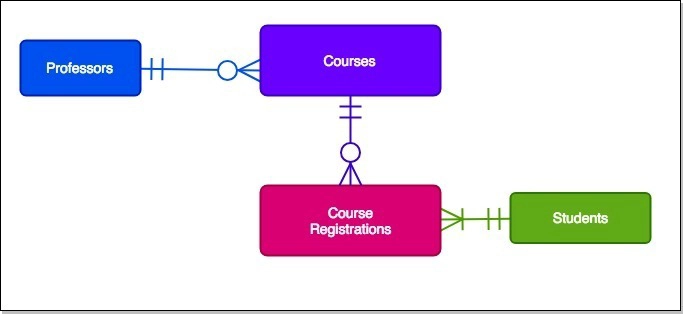Recap
So last time we fixed up the students, professors, and courses relationship. This was done by the amazing application of join tables. Join tables basically, hold references for 2 or more database models that would otherwise have a many-to-many relationship. Which is problematic because it creates a situation where data is duplicated in a bunch of places, leading to low cardinality. Cardinality basically refers to how unique data is in a particular column. While join tables aren't perfect, it's better than keeping entire copies of rows (individual instances of the model) nested in other rows.
Corrections
I made an assumption about the data model for the student based on the desire to show a greater variety of crow's foot notation. But the has one or more course_registrations demarkation of the student is confusing when you think about it. It would lower cardinality so I'm just going to add a boolean data type column called has_registered to alleviate this.
It took this.
Code, yes?
Not quite yet, first some errata.
- I am by no means a DBA(database admin) or anything so I'm not going to get too deep into joins in this one.
- I'm using PostgreSQL. If you don't have it, here's a download link.
- I use an ORM (Object Relational Mapper) in production but you should always know what's going on "under the hood" of whatever abstraction you're using, to a degree. This hopefully sheds some light on what the tools you are using to spin up databases are actually doing.
- There are visualization tools and managers to help you with your databases like pgAdmin. Download it, play with it!
- Forget the UUID thing. It's neat but I don't think introducing modules in PostgreSQL befits a beginner
- I am also omitting what a full-blown version will look like. There's a lot of data to consider and will go into detail on something similar later.
- And finally, at this point, I'm assuming you downloaded PostgreSQL and have it set up.
So here we go:
First, we go the terminal, git bash or power shell (you should be using one of these!) and enter the following:

So in the above code, I entered the DBMS (database management system) and then I created the database that holds my tables. I affectionately called it school_server.
Next up, the tables themselves.

So here I made the professors, students, courses, and course registrations tables. Pay close attention to courses and course_registrations tables. They both contain some foreign keys.
Sounds familiar?
It should, I mentioned previously that foreign keys are used as references that point to the appropriate row in the table that has a relationship with the row that contains that foreign key.
In the case of the courses and course_registration tables, we see 3 different foreign keys. Courses have only one, in the professor_id column. Course_Registrations has two because it is a join table that joins together courses and students. Which are also what its foreign keys point towards. So let's have a gander at what these newly-minted tables look like.
Professors
| id | first_name | last_name |
|---|
Courses
| id | title | description | professor_id |
|---|
Course_Registrations
| id | course_id | student_id |
|---|
Students
| id | first_name | last_name | has_registered |
|---|
This is getting to be a bit long (vertically). So I'm going to call it quits here but, before I close I'll do show you one more thing.
And now our table of students looks like this:
| id | first_name | last_name | has_registered |
|---|---|---|---|
| 1 | Adam | Bean | true |
| 2 | Clara | Does | true |
| 3 | Everett | Franklin | true |
| ---- | ---------- | ---------- | --------- |
Next time, I'll cover the getting a specific student's data, updating, and deleting in SQL. See ya!





Top comments (0)